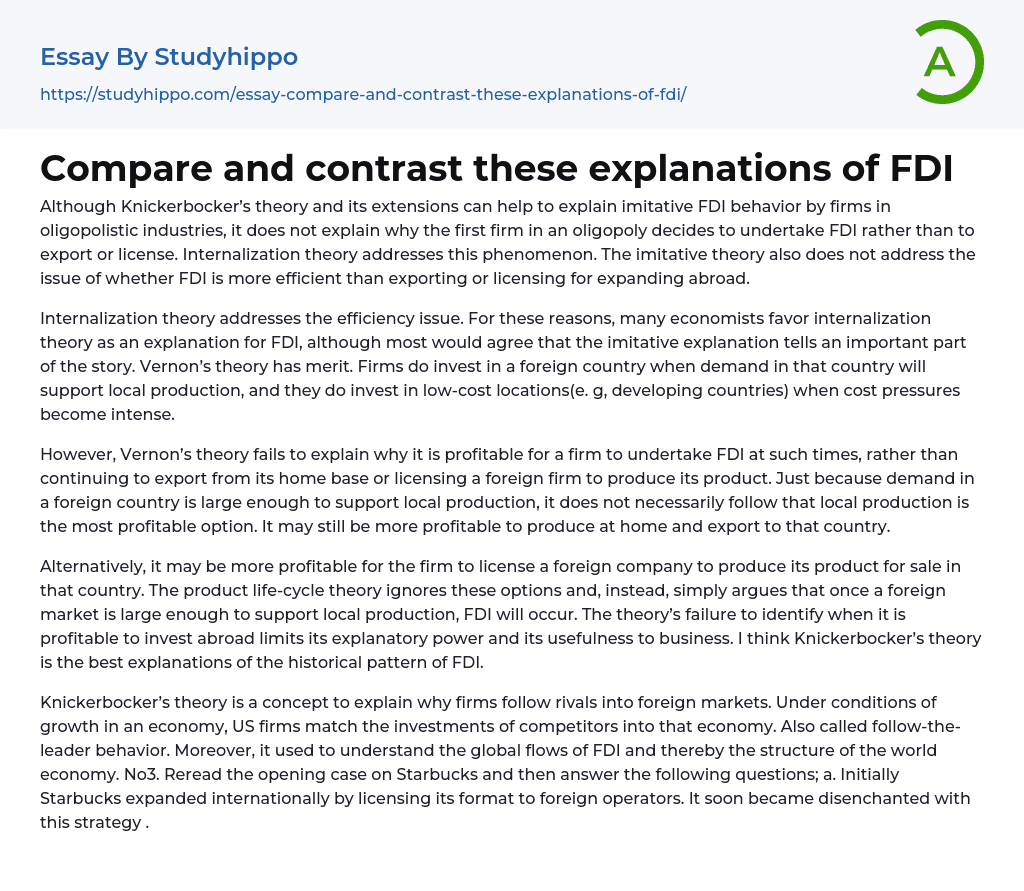

Compare and contrast these explanations of FDI Essay Example
Although Knickerbocker’s theory and its extensions can help to explain imitative FDI behavior by firms in oligopolistic industries, it does not explain why the first firm in an oligopoly decides to undertake FDI rather than to export or license. Internalization theory addresses this phenomenon. The imitative theory also does not address the issue of whether FDI is more efficient than exporting or licensing for expanding abroad.
Internalization theory addresses the efficiency issue. For these reasons, many economists favor internalization theory as an explanation for FDI, although most would agree that the imitative explanation tells an important part of the story. Vernon’s theory has merit. Firms do invest in a foreign country when demand in that country will support local production, and they do invest in low-cost locations(e. g, developin
...g countries) when cost pressures become intense.
However, Vernon’s theory fails to explain why it is profitable for a firm to undertake FDI at such times, rather than continuing to export from its home base or licensing a foreign firm to produce its product. Just because demand in a foreign country is large enough to support local production, it does not necessarily follow that local production is the most profitable option. It may still be more profitable to produce at home and export to that country.
Alternatively, it may be more profitable for the firm to license a foreign company to produce its product for sale in that country. The product life-cycle theory ignores these options and, instead, simply argues that once a foreign market is large enough to support local production, FDI will occur. The theory’s failure to identify when i
is profitable to invest abroad limits its explanatory power and its usefulness to business. I think Knickerbocker’s theory is the best explanations of the historical pattern of FDI.
Knickerbocker’s theory is a concept to explain why firms follow rivals into foreign markets. Under conditions of growth in an economy, US firms match the investments of competitors into that economy. Also called follow-the-leader behavior. Moreover, it used to understand the global flows of FDI and thereby the structure of the world economy. No3. Reread the opening case on Starbucks and then answer the following questions; a. Initially Starbucks expanded internationally by licensing its format to foreign operators. It soon became disenchanted with this strategy .
- Finance essays
- International Business essays
- Macroeconomics essays
- Barriers To Entry essays
- Microeconomics essays
- Pricing essays
- Profit essays
- Consumerism essays
- Export essays
- Free Trade essays
- International Trade essays
- Compensation essays
- Monopoly essays
- Trade essays
- Industry essays
- Warehouse essays
- Economic Development essays
- Economic Growth essays
- Inflation essays
- Taxation essays
- Central Bank essays
- Monetary Policy essays
- Economy essays
- Gross Domestic Product essays
- Recession essays
- Capitalism essays
- Economic System essays
- Materialism essays
- World economy essays
- American Dream essays
- resources essays
- Max Weber essays
- Employment essays
- Minimum Wage essays
- Unemployment essays
- Human Development essays
- Income Inequality essays
- Economic Inequality essays
- Money essays
- Financial Accounting essays
- Market Segmentation essays
- Supply And Demand essays
- Purchasing essays
- Forecasting essays
- Legacy essays
- Bank essays
- Corporate Finance essays
- Financial News essays
- Financial Ratios essays
- Financial Services essays



